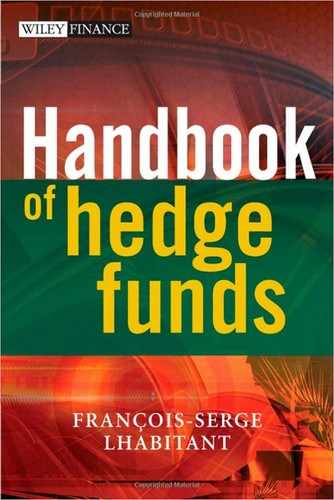6
Introduction
Psychology tends to produce too many subjective answers and no objective theory.
Although the term “hedge funds” is often used generically, it is essential to understand that, in reality, hedge funds no longer form a homogeneous group. As hedge funds have gained size and popularity, they have deviated from the original Alfred W. Jones’ model and are now following a plethora of investment strategies with very different risk and return characteristics. Of course, one could argue that their situation is not fundamentally different from the one that prevails with traditional asset classes – equities can be split by industrial sectors, growth and value styles, and cyclical and non-cyclical categories, and bonds can be analysed by durations, credit categories, or industry and geographic categories. Nevertheless, despite the existence of many subcategories, equities and bonds still have some common factors throughout their respective asset class. By contrast, it is usually difficult to identify a common factor for hedge funds beyond the “unregulated” and “privately-offered” attributes. Nevertheless, understanding the common nature as well as the differences between funds that follow the same investment strategy is crucial in order to develop a coherent investment plan.
To analyse hedge funds, consultants, investors and managers alike need to segregate their universe into a range of standardized investment styles. Unfortunately, there is no accepted norm to classify the different hedge fund strategies, and each consultant, investor, manager or hedge fund data provider may design its own classification or decide to adopt an external one. A survey launched by the Alternative Investment Management Association in 2003 evidenced that 50% of the respondents used their own strategy classification, 47% used one or more outside classification systems, while the balance (3%) stated that hedge funds could not be classified. Among the group that used outside classification sources, the primary classifications mentioned were those of CS/Tremont (27%) and Hedge Fund Research (27%), closely followed by MSCI (23%) as well as those of the CISDM, Eurekahedge and Cogent Hedge databases.
In the following, for the sake of simplicity, we have decided to match the classification suggested by CS/Tremont. Note that we do not claim that this classification is better than existing ones. It is just a working tool that is compatible with most existing classifications. Understanding how the universe of strategies is split according to CS/Tremont allows the reader to derive its own classification if he or she wants it.
CS/Tremont distinguishes 10 different strategies. To summarize:
• Long/short equity funds invest in equities, and combine long investments with short sales to reduce but not to completely eliminate market exposure.
• Dedicated short funds only use short positions. In a sense, they are the mirrors of traditional long-only managers.
• Equity market neutral funds seek to exploit pricing inefficiencies between related equity securities while at the same time exactly neutralizing exposure to market risk.
• Distressed securities funds focus on debt or equity of companies that are or are expected to be in financial or operational difficulty. This may involve reorganizations, bankruptcies, distressed sales and other corporate restructurings.
• Merger arbitrage funds invest in event-driven situations such as mergers or acquisitions, including leveraged buyouts, mergers, or hostile takeovers.
• Convertible bond arbitrage funds seek to exploit pricing anomalies between convertible bonds and their underlying equity.
• Fixed income arbitrage funds use a wide spectrum of strategies that seek to exploit pricing anomalies within and across global fixed income markets.
• Emerging market funds invest in all types of securities in emerging countries, including equities, bonds, and sovereign debt.
• Global macro funds tend to make leveraged, directional, opportunistic investments in global currency, equity, bond and commodity markets on a discretionary basis.
• Managed futures (commodity trading advisers) trade primarily listed commodity and financial futures contracts on behalf of their clients, mostly on an algorithmic basis.
Each of these strategies will be analysed in a separate chapter, with examples of trades. We invite the reader to understand how these trades work, their rationale as well as the associated risks because we believe that this is actually the best way to get some insight in hedge fund strategies. In addition, we will also illustrate a series of some less popular hedge fund strategies in a dedicated chapter – in a sense, these are the alternative strategies of today’s hedge fund managers, and some of them may become the leading strategies of tomorrow.
Figure 6.1 illustrates the breakdown of hedge fund assets by investment strategy, based on the CS/Tremont index in May 2006. This breakdown has significantly changed over the years. In the mid-1990s, global macro funds were the Titans of finance and controlled almost two-thirds of hedge fund assets. But this ended in 2000 when two colossi of the industry – George Soros and Julian Robertson ($22 and $20 billion at their respective peaks) – retreated from a game whose rules seemed to have changed. Since, global macro has experienced a significant decline in market share for the profit of long/short equity, which is now the dominant force (28%) of the industry. This is the direct consequence of the long bear market of the early 2000s. Several long-only managers closed their traditional funds to open a new hedge fund in order to be able to sell short . . .and capture performance fees. However, as we will see, long/short equity is an easy strategy to understand, but picking the best managers is a daunting task.
Figure 6.1 Breakdown of hedge fund assets by investment strategy (based on the CS/Tremont index)

..................Content has been hidden....................
You can't read the all page of ebook, please click here login for view all page.
